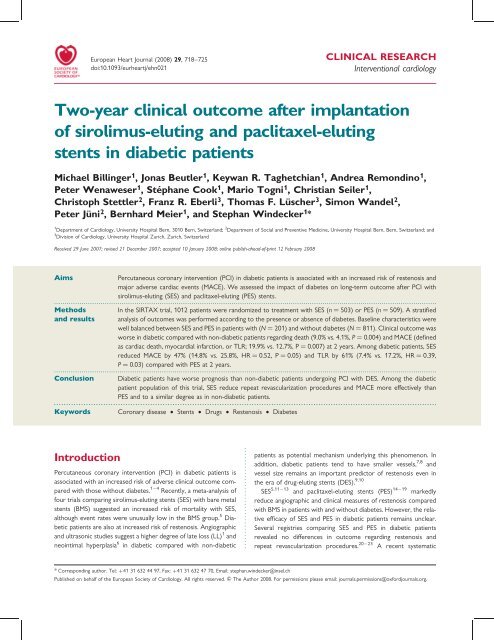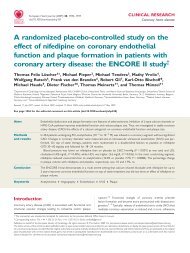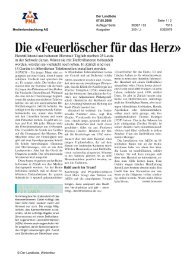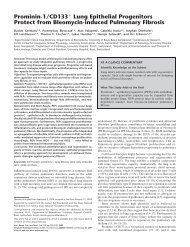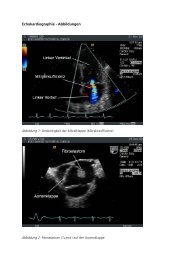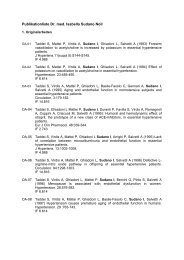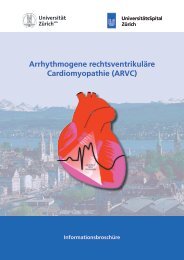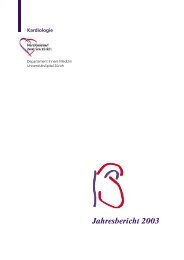Two-year clinical outcome after implantation of sirolimus-eluting and ...
Two-year clinical outcome after implantation of sirolimus-eluting and ...
Two-year clinical outcome after implantation of sirolimus-eluting and ...
Create successful ePaper yourself
Turn your PDF publications into a flip-book with our unique Google optimized e-Paper software.
European Heart Journal (2008) 29, 718–725<br />
doi:10.1093/eurheartj/ehn021<br />
CLINICAL RESEARCH<br />
Interventional cardiology<br />
<strong>Two</strong>-<strong>year</strong> <strong>clinical</strong> <strong>outcome</strong> <strong>after</strong> <strong>implantation</strong><br />
<strong>of</strong> <strong>sirolimus</strong>-<strong>eluting</strong> <strong>and</strong> paclitaxel-<strong>eluting</strong><br />
stents in diabetic patients<br />
Michael Billinger 1 , Jonas Beutler 1 , Keywan R. Taghetchian 1 , Andrea Remondino 1 ,<br />
Peter Wenaweser 1 , Stéphane Cook 1 , Mario Togni 1 , Christian Seiler 1 ,<br />
Christoph Stettler 2 , Franz R. Eberli 3 , Thomas F. Lüscher 3 , Simon W<strong>and</strong>el 2 ,<br />
Peter Jüni 2 , Bernhard Meier 1 , <strong>and</strong> Stephan Windecker 1 *<br />
1 Department <strong>of</strong> Cardiology, University Hospital Bern, 3010 Bern, Switzerl<strong>and</strong>; 2 Department <strong>of</strong> Social <strong>and</strong> Preventive Medicine, University Hospital Bern, Bern, Switzerl<strong>and</strong>; <strong>and</strong><br />
3 Division <strong>of</strong> Cardiology, University Hospital Zurich, Zurich, Switzerl<strong>and</strong><br />
Received 29 June 2007; revised 21 December 2007; accepted 10 January 2008; online publish-ahead-<strong>of</strong>-print 12 February 2008<br />
Aims<br />
Percutaneous coronary intervention (PCI) in diabetic patients is associated with an increased risk <strong>of</strong> restenosis <strong>and</strong><br />
major adverse cardiac events (MACE). We assessed the impact <strong>of</strong> diabetes on long-term <strong>outcome</strong> <strong>after</strong> PCI with<br />
<strong>sirolimus</strong>-<strong>eluting</strong> (SES) <strong>and</strong> paclitaxel-<strong>eluting</strong> (PES) stents.<br />
.....................................................................................................................................................................................<br />
Methods In the SIRTAX trial, 1012 patients were r<strong>and</strong>omized to treatment with SES (n ¼ 503) or PES (n ¼ 509). A stratified<br />
<strong>and</strong> results analysis <strong>of</strong> <strong>outcome</strong>s was performed according to the presence or absence <strong>of</strong> diabetes. Baseline characteristics were<br />
well balanced between SES <strong>and</strong> PES in patients with (N ¼ 201) <strong>and</strong> without diabetes (N ¼ 811). Clinical <strong>outcome</strong> was<br />
worse in diabetic compared with non-diabetic patients regarding death (9.0% vs. 4.1%, P ¼ 0.004) <strong>and</strong> MACE (defined<br />
as cardiac death, myocardial infarction, or TLR; 19.9% vs. 12.7%, P ¼ 0.007) at 2 <strong>year</strong>s. Among diabetic patients, SES<br />
reduced MACE by 47% (14.8% vs. 25.8%, HR ¼ 0.52, P ¼ 0.05) <strong>and</strong> TLR by 61% (7.4% vs. 17.2%, HR ¼ 0.39,<br />
P ¼ 0.03) compared with PES at 2 <strong>year</strong>s.<br />
.....................................................................................................................................................................................<br />
Conclusion<br />
Diabetic patients have worse prognosis than non-diabetic patients undergoing PCI with DES. Among the diabetic<br />
patient population <strong>of</strong> this trial, SES reduce repeat revascularization procedures <strong>and</strong> MACE more effectively than<br />
PES <strong>and</strong> to a similar degree as in non-diabetic patients.<br />
-----------------------------------------------------------------------------------------------------------------------------------------------------------<br />
Keywords Coronary disease † Stents † Drugs † Restenosis † Diabetes<br />
Introduction<br />
Percutaneous coronary intervention (PCI) in diabetic patients is<br />
associated with an increased risk <strong>of</strong> adverse <strong>clinical</strong> <strong>outcome</strong> compared<br />
with those without diabetes. 1–4 Recently, a meta-analysis <strong>of</strong><br />
four trials comparing <strong>sirolimus</strong>-<strong>eluting</strong> stents (SES) with bare metal<br />
stents (BMS) suggested an increased risk <strong>of</strong> mortality with SES,<br />
although event rates were unusually low in the BMS group. 5 Diabetic<br />
patients are also at increased risk <strong>of</strong> restenosis. Angiographic<br />
<strong>and</strong> ultrasonic studies suggest a higher degree <strong>of</strong> late loss (LL) 1 <strong>and</strong><br />
neointimal hyperplasia 6 in diabetic compared with non-diabetic<br />
patients as potential mechanism underlying this phenomenon. In<br />
addition, diabetic patients tend to have smaller vessels, 7,8 <strong>and</strong><br />
vessel size remains an important predictor <strong>of</strong> restenosis even in<br />
the era <strong>of</strong> drug-<strong>eluting</strong> stents (DES). 9,10<br />
SES 5,11 – 13 <strong>and</strong> paclitaxel-<strong>eluting</strong> stents (PES) 14 – 19 markedly<br />
reduce angiographic <strong>and</strong> <strong>clinical</strong> measures <strong>of</strong> restenosis compared<br />
with BMS in patients with <strong>and</strong> without diabetes. However, the relative<br />
efficacy <strong>of</strong> SES <strong>and</strong> PES in diabetic patients remains unclear.<br />
Several registries comparing SES <strong>and</strong> PES in diabetic patients<br />
revealed no differences in <strong>outcome</strong> regarding restenosis <strong>and</strong><br />
20 – 23<br />
repeat revascularization procedures. A recent systematic<br />
* Corresponding author. Tel: þ41 31 632 44 97, Fax: þ41 31 632 47 70, Email: stephan.windecker@insel.ch<br />
Published on behalf <strong>of</strong> the European Society <strong>of</strong> Cardiology. All rights reserved. & The Author 2008. For permissions please email: journals.permissions@oxfordjournals.org.
<strong>Two</strong>-<strong>year</strong> <strong>clinical</strong> <strong>outcome</strong> <strong>after</strong> <strong>implantation</strong> <strong>of</strong> SES <strong>and</strong> PES 719<br />
review <strong>of</strong> 10 r<strong>and</strong>omized trials indirectly comparing SES with PES<br />
reported superior <strong>outcome</strong> regarding restenosis <strong>and</strong> major<br />
adverse cardiac events (MACE) with SES in non-diabetic patients,<br />
whereas there was no difference between both stent types in diabetic<br />
patients. 24 One dedicated r<strong>and</strong>omized trial directly comparing<br />
SES <strong>and</strong> PES in 250 diabetic patients observed significantly<br />
lower LL <strong>and</strong> restenosis in favour <strong>of</strong> SES, 25 but the study was<br />
not powered to detect differences in <strong>clinical</strong> <strong>outcome</strong>.<br />
The objective <strong>of</strong> the present study was to evaluate the longterm<br />
<strong>clinical</strong> <strong>outcome</strong> <strong>of</strong> patients stratified according to diabetic<br />
status, which was a pre-specified stratified analysis <strong>of</strong> the r<strong>and</strong>omized<br />
SIRTAX trial. 26<br />
Methods<br />
Patient population <strong>and</strong> intervention<br />
The design <strong>of</strong> the SIRTAX trial has been previously reported. 26 It was<br />
an observer blind, r<strong>and</strong>omized controlled trial comparing safety <strong>and</strong><br />
efficacy <strong>of</strong> SES <strong>and</strong> PES in 1012 patients undergoing PCI. Eligible<br />
patients had a history <strong>of</strong> stable angina or acute coronary syndrome<br />
<strong>and</strong> presented with at least one lesion with a diameter stenosis<br />
50% in a vessel with a reference vessel diameter (RVD) between<br />
2.25 <strong>and</strong> 4.00 mm suitable for stent <strong>implantation</strong>. There were no limitations<br />
on the number <strong>of</strong> treated lesions <strong>and</strong> vessels, or lesion length.<br />
The study complied with the Declaration <strong>of</strong> Helsinki regarding investigations<br />
in humans <strong>and</strong> was approved by the institutional ethics committees<br />
at the University Hospitals <strong>of</strong> Bern <strong>and</strong> Zurich, Switzerl<strong>and</strong>.<br />
All patients provided written informed consent.<br />
Patients were r<strong>and</strong>omly assigned on a 1 : 1 basis to treatment with<br />
SES (Cypher w ; Cordis) or PES (Taxus w , Boston Scientific). Before or<br />
at the time <strong>of</strong> the procedure, patients received at least 100 mg <strong>of</strong><br />
aspirin, a 300 mg loading dose <strong>of</strong> clopidogrel, <strong>and</strong> unfractionated<br />
heparin (70–100 U/kg <strong>of</strong> body weight). After the procedure, all<br />
patients were advised to maintain aspirin lifelong, <strong>and</strong> clopidogrel<br />
therapy was prescribed for 12 months irrespective <strong>of</strong> stent type.<br />
Study endpoints <strong>and</strong> definitions<br />
Adverse events were assessed in hospital, at 1, 6, <strong>and</strong> 9 months, 1 <strong>and</strong><br />
2 <strong>year</strong>s. An independent <strong>clinical</strong> events committee unaware <strong>of</strong> the<br />
patients’ treatment assignments adjudicated all endpoints.<br />
The pre-specified primary endpoint was a composite <strong>of</strong> MACE,<br />
defined as cardiac death, myocardial infarction (MI), or ischaemiadriven<br />
revascularization <strong>of</strong> the target lesion at 9 months. Secondary<br />
endpoints included ischaemia-driven TLR, TVR, or target-vessel<br />
failure (TVF). TLR <strong>and</strong> TVR were considered to be driven by ischaemia<br />
if the stenosis <strong>of</strong> the target lesion or vessel was 50% on the basis <strong>of</strong><br />
quantitative coronary angiography in the presence <strong>of</strong> ischaemic signs<br />
or symptoms, or if there was a stenosis <strong>of</strong> 70% in the absence <strong>of</strong><br />
ischaemic signs or symptoms. TLR was defined as a repeated revascularization<br />
based on a stenosis within the stent or within the 5 mm<br />
borders proximal or distal to the stent. The diagnosis <strong>of</strong> periprocedural<br />
MI was established whenever new Q-waves <strong>of</strong> at least 0.4 s<br />
duration in at least two contiguous leads appeared on the electrocardiogram<br />
with an elevated creatine kinase MB fraction level, or in the<br />
absence <strong>of</strong> pathological Q waves, an elevation in creatine kinase<br />
levels to more than twice the upper limit <strong>of</strong> normal with an elevated<br />
creatine kinase MB or troponin I level. Stent thrombosis was defined<br />
as an acute coronary syndrome with angiographic documentation <strong>of</strong><br />
either target vessel occlusion or thrombus within or adjacent to the<br />
previously successfully stented segment.<br />
Angiographic core laboratory analysis was performed as previously<br />
described by angiogram readers unaware <strong>of</strong> the type <strong>of</strong> stent<br />
implanted. 26 Quantitative measurements included RVD, minimal<br />
luminal diameter (MLD), <strong>and</strong> % diameter stenosis.<br />
Statistical analysis<br />
We pre-specified stratified analysis <strong>of</strong> the primary <strong>outcome</strong> according<br />
to the presence or absence <strong>of</strong> diabetes. All r<strong>and</strong>omized patients<br />
were included in the analysis <strong>of</strong> primary <strong>and</strong> secondary <strong>clinical</strong> <strong>outcome</strong>s<br />
in the groups to which they were originally allocated to<br />
(intention-to-treat principle). Baseline characteristics were compared<br />
between diabetic <strong>and</strong> non-diabetic patients using x 2 test without<br />
taking into account the r<strong>and</strong>om allocation to SES or PES. We<br />
used a Cox proportional-hazards model to compare <strong>clinical</strong> <strong>outcome</strong>s<br />
between the groups. P-values for differences in <strong>clinical</strong> <strong>outcome</strong>s<br />
between diabetic <strong>and</strong> non-diabetic patients were derived<br />
from Cox proportional hazard models adjusted for treatment allocation.<br />
To determine whether there was an interaction between<br />
treatment effect <strong>and</strong> diabetic status, we used likelihood ratio tests.<br />
Analyses were performed in Stata 9.2 (Stata, Inc., College Station,<br />
TX, USA). No adjustments were made for multiple comparisons in<br />
secondary analyses; P-values are two-sided with a significance level<br />
<strong>of</strong> 0.05.<br />
Results<br />
Baseline <strong>clinical</strong>, angiographic,<br />
<strong>and</strong> procedural data<br />
A total <strong>of</strong> 1012 patients were r<strong>and</strong>omized to treatment with SES<br />
(503 patients with 694 lesions) <strong>and</strong> PES (509 patients with 715<br />
lesions). <strong>Two</strong> hundred <strong>and</strong> one patients (20%) with 292 lesions<br />
were diabetic, <strong>of</strong> whom 43 patients (21.4%) required insulin.<br />
Among diabetic patients, 108 patients with 158 lesions received<br />
SES, whereas 93 patients with 134 lesions received PES.<br />
Baseline <strong>clinical</strong> variables were well balanced between SES <strong>and</strong><br />
PES in both, diabetic <strong>and</strong> non-diabetic patients (Table 1). Patients<br />
with diabetes compared with those without diabetes were older<br />
(P , 0.001), more commonly hypertensive (P , 0.001), more<br />
<strong>of</strong>ten female (P ¼ 0.01), <strong>and</strong> had a higher rate <strong>of</strong> multivessel<br />
disease (P ¼ 0.05). Previous MI (P ¼ 0.06) tended to be more<br />
prevalent, whereas smoking (P , 0.001) was less frequent in diabetic<br />
than in non-diabetic patients. Target lesion location <strong>and</strong><br />
angiographic lesion characteristics at baseline revealed no significant<br />
differences between SES <strong>and</strong> PES in diabetic <strong>and</strong> non-diabetic<br />
patients (Table 2). Procedural <strong>and</strong> angiographic results are summarized<br />
in Table 3, showing similar <strong>outcome</strong> in SES- <strong>and</strong> PES-treated<br />
diabetic <strong>and</strong> non-diabetic patients. Clinical <strong>outcome</strong>s were<br />
obtained for 1007 (99.5%) <strong>of</strong> the 1012 r<strong>and</strong>omized patients<br />
during 2 <strong>year</strong>s <strong>of</strong> follow-up. Five patients lost to follow-up all<br />
belonged to the PES group, three patients were lost during the<br />
first <strong>and</strong> two patients during the second <strong>year</strong>.<br />
Clinical <strong>outcome</strong>s<br />
Clinical events at 2-<strong>year</strong> follow-up stratified for diabetic status are<br />
summarized in Table 4. Rates <strong>of</strong> death (9.0% vs. 4.1%, P ¼ 0.004),<br />
cardiac death (7.0% vs. 2.1%, P , 0.001), target lesion
720<br />
M. Billinger et al<br />
Table 1 Baseline <strong>clinical</strong> characteristics<br />
Diabetic patients<br />
..............................<br />
Non-diabetic patients<br />
.................................<br />
P-value<br />
SES PES SES PES<br />
...............................................................................................................................................................................<br />
Total (n) 108 93 395 416<br />
Age65 <strong>year</strong>s [n (%)] 62 (57.4) 59 (63.4) 155 (39.2) 166 (39.9) ,0.001<br />
Males [n (%)] 75 (69.4) 67 (72.0) 307(77.7) 332 (79.8) 0.01<br />
Hypertension [n (%)] 86 (79.6) 76 (81.7) 216 (54.7) 244 (58.7) ,0.001<br />
Hyperlipidaemia [n (%)] 71 (65.7) 52 (55.9) 234 (59.2) 240 (57.7) 0.48<br />
Current smoking [n (%)] 25 (23.2) 16 (17.2) 159 (40.3) 165 (39.7) ,0.001<br />
Previous myocardial infarction [n (%)] 38 (35.2) 32 (34.4) 107 (27.1) 120 (28.9) 0.06<br />
Stable angina pectoris [n (%)] 60 (55.6) 48 (51.6) 186 (47.1) 198 (47.6) 0.11<br />
Acute coronary syndromes [n (%)] 48 (44.4) 45 (48.4) 209 (52.9) 218 (52.4) 0.21<br />
Unstable angina [n (%)] 6 (5.6) 7 (7.5) 22 (5.6) 23 (5.5)<br />
Non-ST-elevation MI [n (%)] 22 (20.4) 23 (24.7) 90 (22.8) 100 (24.0)<br />
ST-elevation MI [n (%)] 20 (18.5) 15 (16.1) 97 (24.6) 95 (22.8)<br />
Multivessel disease [n (%)] 75 (69.4) 57 (61.3) 225 (57.0) 245 (58.9) 0.05<br />
Left anterior descending coronary artery as target vessel [n (%)] 57 (52.8) 52 (55.9) 211 (53.4) 223 (53.6) 0.86<br />
Small vessel disease [n (%)] 57 (52.8) 50 (53.8) 186 (47.1) 215 (51.7) 0.34<br />
Long target lesion 23 (21.3) 19 (20.4) 78 (19.8) 98 (23.6) 0.77<br />
Table 2 Baseline lesion characteristics<br />
Diabetic patients<br />
........................................<br />
Non-diabetic patients<br />
........................................<br />
P-value<br />
SES PES SES PES<br />
...............................................................................................................................................................................<br />
Total number <strong>of</strong> lesions 158 134 536 581<br />
...............................................................................................................................................................................<br />
Target lesion coronary artery [n (%)]<br />
Left main 3 (1.9) 2 (1.5) 8 (1.5) 9 (1.6) 0.82<br />
Left anterior descending 74 (46.8) 62 (46.3) 250 (46.6) 261 (44.9) 0.82<br />
Left circumflex 27 (17.1) 29 (21.6) 112 (20.9) 110 (18.9) 0.80<br />
Right 52 (32.9) 38 (28.4) 157 (29.3) 191 (32.9) 0.93<br />
Bypass graft 2 (1.3) 3 (2.2) 9 (1.7) 10 (1.7) 0.99<br />
...............................................................................................................................................................................<br />
ACC-AHA lesion class [n (%)]<br />
A 29 (18.4) 24 (17.9) 102 (19.0) 130 (22.4) 0.37<br />
B1 70 (44.3) 62 (46.3) 230 (42.9) 245 (42.2) 0.46<br />
B2 37 (23.4) 26 (19.4) 137 (25.6) 132 (22.7) 0.43<br />
C 22 (13.9) 22 (16.4) 67 (12.5) 74 (12.7) 0.35<br />
...............................................................................................................................................................................<br />
Angiographic measures<br />
Lesion length (mm + SD) 11.1 + 5.4 11.8 + 7.9 12.1 + 7.4 12.5 + 7.0 0.10<br />
Reference vessel diameter (mm + SD) 2.86 + 0.41 2.74 + 0.40 2.81 + 0.40 2.84 + 0.44 0.51<br />
Minimal lumen diameter (mm + SD) 0.55 + 0.49 0.53 + 0.46 0.52 + 0.44 0.53 + 0.42 0.59<br />
Stenosis (% lumen diameter + SD) 81.4 + 15.0 80.8 + 15.6 81.6 + 15.1 81.3 + 14.1 0.73<br />
revascularization (11.9% vs. 10.0%, P ¼ 0.33), <strong>and</strong> MACE (19.9% vs.<br />
12.7%, P ¼ 0.007) were higher in diabetic than in non-diabetic<br />
patients at 2 <strong>year</strong>s.<br />
Among diabetic patients, SES more effectively reduced MACE<br />
than PES (14.8% vs. 25.8%, HR ¼ 0.52; 95% CI 0.28–0.99;<br />
P ¼ 0.05) (Figure 1A). This difference was largely driven by a<br />
reduction in the risk <strong>of</strong> TLR in favour <strong>of</strong> SES (7.4% vs. 17.2%,<br />
HR ¼ 0.39; 95% CI 0.17–0.90; P ¼ 0.03) (Figure 1B). The therapeutic<br />
benefit <strong>of</strong> SES over PES in diabetic patients was maintained<br />
at 2 <strong>year</strong>s <strong>of</strong> follow-up. SES compared with PES reduced rates <strong>of</strong><br />
MACE (HR ¼ 0.42, 95% CI 0.19–0.93, P ¼ 0.03) <strong>and</strong> TLR (HR ¼<br />
0.36, 95% CI 0.13–0.98, P ¼ 0.05) to a similar degree in noninsulin-dependent<br />
diabetics as in non-diabetic patients. In contrast,<br />
rates <strong>of</strong> MACE were similar for SES (20.0%) <strong>and</strong> PES (23.5%) in
<strong>Two</strong>-<strong>year</strong> <strong>clinical</strong> <strong>outcome</strong> <strong>after</strong> <strong>implantation</strong> <strong>of</strong> SES <strong>and</strong> PES 721<br />
Table 3 Procedural results<br />
Diabetic patients<br />
.......................................<br />
Non-diabetic patients<br />
.......................................<br />
P-value<br />
SES PES SES PES<br />
...............................................................................................................................................................................<br />
Total number <strong>of</strong> lesions 158 134 536 581<br />
...............................................................................................................................................................................<br />
Procedures<br />
Lesions treated per patient (n + SD) 1.46 + 0.65 1.44 + 0.63 1.36 + 0.57 1.40 + 0.59 0.13<br />
Stents per lesion (n + SD) 1.14 + 0.45 1.13 + 0.40 1.11 + 0.36 1.16 + 0.46 0.90<br />
Minimal stent diameter (mm + SD) 2.89 + 0.40 2.80 + 0.36 2.88 + 0.37 2.91 + 0.37 0.10<br />
Stent length per lesion (mm + SD) 18.5 + 10.7 18.7 + 12.1 18.7 + 10.2 19.0 + 10.3 0.71<br />
Maximal pressure (atm + SD) 14.4 + 3.2 13.9 + 2.7 14.4 + 3.2 14.1 + 2.9 0.65<br />
...............................................................................................................................................................................<br />
Angiographic results<br />
Final minimal lumen diameter (mm+SD)<br />
In-stent 2.66 + 0.36 2.62 + 0.41 2.65 + 0.37 2.69 + 0.38 0.34<br />
In-segment 2.57 + 0.40 2.55 + 0.40 2.55 + 0.41 2.61 + 0.44 0.66<br />
Final stenosis (% <strong>of</strong> lumen diameter + SD)<br />
In-stent 7.57 + 4.75 6.82 + 8.24 7.20 + 4.75 6.78 + 4.67 0.58<br />
In-segment 8.92 + 7.47 8.92 + 6.61 8.87 + 7.32 8.26 + 6.56 0.62<br />
Acute gain (mm + SD)<br />
In-stent 2.11 + 0.51 2.09 + 0.51 2.13 + 0.52 2.16 + 0.51 0.23<br />
In-segment 2.10 + 0.53 1.94 + 0.57 2.06 + 0.53 2.10 + 0.55 0.33<br />
Table 4 Clinical events through 2 <strong>year</strong>s stratified by diabetes<br />
Diabetic patients Non-diabetic patients P-value for<br />
............................................................ ............................................................. interaction*<br />
SES PES Hazard ratio P-value SES PES Hazard ratio P-value<br />
(95% CI)<br />
(95% CI)<br />
...............................................................................................................................................................................<br />
Total number <strong>of</strong> 108 93 395 416<br />
patients (n)<br />
...............................................................................................................................................................................<br />
Events at 24 months<br />
[n (%)]<br />
Death 9 (8.3) 10 (10.8) 0.75 (0.30–1.83) 0.52 16 (4.1) 17 (4.1) 0.98 (0.50–1.95) 0.99 0.62<br />
Cardiac death 7 (6.5) 7 (7.5) 0.83 (0.29–2.37) 0.73 6 (1.5) 11 (2.6) 0.57 (0.21–1.54) 0.27 0.61<br />
Myocardial infarction 2 (1.9) 6 (6.5) 0.28 (0.06–1.38) 0.12 16 (4.1) 18 (4.3) 0.93 (0.48–1.83) 0.84 0.15<br />
Q-wave 0 (0.0) 2 (2.2) 0.17 (0.01–3.56) 0.13 8 (2.0) 5 (1.2) 1.69 (0.55–5.16) 0.36 0.14<br />
Non-Q-wave 2 (1.9) 4 (4.3) 0.43 (0.08–2.33) 0.32 8 (2.0) 13 (3.1) 0.64 (0.27–1.55) 0.33 0.65<br />
Target lesion<br />
8 (7.4) 16 (17.2) 0.39 (0.17–0.90) 0.03 31 (7.9) 50 (12.0) 0.64 (0.41–1.00) 0.05 0.32<br />
revascularization<br />
Percutaneous 6 (5.6) 14 (15.1) 0.33 (0.13–0.86) 0.02 29 (7.3) 44 (10.6) 0.68 (0.42–1.08) 0.10 0.19<br />
Surgical 2 (1.9) 4 (4.3) 0.41 (0.08–2.25) 0.31 3 (0.8) 10 (2.4) 0.31 (0.09–1.13) 0.08 0.80<br />
Target vessel 10 (9.3) 17 (18.3) 0.48 (0.22–1.05) 0.07 37 (9.4) 57 (13.7) 0.67 (0.44–1.02) 0.06 0.47<br />
revascularization<br />
Percutaneous 8 (7.4) 15 (16.1) 0.41 (0.17–0.97) 0.04 35 (8.9) 51 (12.3) 0.70 (0.46–1.08) 0.11 0.28<br />
Surgical 2 (1.9) 4 (4.3) 0.41 (0.08–2.25) 0.31 3 (0.8) 10 (2.4) 0.31 (0.09–1.13) 0.08 0.80<br />
Stent thrombosis 1 (0.9) 3 (3.2) 0.27 (0.03–2.60) 0.26 11 (2.8) 11 (2.6) 1.06 (0.46–2.43) 0.94 0.25<br />
Major adverse cardiac 16 (14.8) 24 (25.8) 0.52 (0.28–0.99) 0.05 40 (10.1) 63 (15.1) 0.65 (0.44–0.96) 0.03 0.58<br />
events<br />
Target vessel failure 18 (16.7) 25 (26.9) 0.57 (0.31–1.04) 0.07 44 (11.1) 70 (16.8) 0.64 (0.44–0.93) 0.03 0.73<br />
Death, myocardial 11 (10.2) 16 (17.2) 0.52 (0.22–1.19) 0.12 31 (7.9) 33 (7.9) 1.06 (0.63–1.76) 0.85 0.15<br />
infarction, or stent<br />
thrombosis<br />
*P-values for interaction relate to differences in hazard ratios between diabetic <strong>and</strong> non-diabetic patients.<br />
Hazard ratios <strong>and</strong> P-values are from Cox Proportional Hazards Models.
722<br />
M. Billinger et al<br />
Figure 1 Kaplan–Meier cumulative event curves <strong>of</strong> (A) major adverse cardiac events in patients with diabetes stratified for stent type <strong>and</strong> (B)<br />
target lesion revascularization in patients with diabetes stratified for stent type.<br />
insulin-dependent diabetic patients (HR ¼ 0.80, 95% CI 0.28–2.31,<br />
P ¼ 0.68).<br />
There were no significant differences between SES <strong>and</strong> PES in<br />
diabetics with respect to death (P ¼ 0.52), cardiac death<br />
(P ¼ 0.73), or MI (P ¼ 0.12) at 2 <strong>year</strong>s. Stent thrombosis<br />
amounted to 0.9% for SES <strong>and</strong> 3.2% for PES (HR ¼ 0.27; 95% CI<br />
0.03–2.60, P ¼ 0.25), <strong>and</strong> the composite <strong>of</strong> death, MI, or stent<br />
thrombosis was 10.2% for SES <strong>and</strong> 17.2% for PES (HR ¼ 0.52,<br />
95% CI 0.22–1.19, P ¼ 0.12) in diabetic patients.<br />
Among patients without diabetes, the rates <strong>of</strong> MACE (10.4% vs.<br />
15.1%, HR ¼ 0.65, 95% CI 0.44–0.96; P ¼ 0.04) <strong>and</strong> TLR (7.9% vs.<br />
12.0%, HR ¼ 0.64, 95% CI 0.41–1.00, P ¼ 0.05) were lower for<br />
SES than for PES at 2 <strong>year</strong>s. There were no significant differences<br />
regarding death (P ¼ 0.99), cardiac death (P ¼ 0.27), or MI<br />
(P ¼ 0.84) during long-term follow-up. Similarly, there were no<br />
differences regarding stent thrombosis (SES: 2.8% vs. PES: 2.6%,<br />
HR ¼ 1.06; 95% CI 0.46–2.43, P ¼ 0.94) <strong>and</strong> the composite <strong>of</strong><br />
death, MI, or stent thrombosis (SES: 7.9% vs. PES: 7.9%, HR ¼<br />
1.06, 95% CI 0.63–1.76, P ¼ 0.85) in non-diabetic patients. None<br />
<strong>of</strong> the tests for interaction between diabetes status <strong>and</strong> treatment<br />
effect <strong>of</strong> SES compared with PES reached conventional levels <strong>of</strong><br />
statistical significance.<br />
Discussion<br />
The principal findings <strong>of</strong> the present study can be summarized<br />
as follows.<br />
(i) Diabetic patients have worse prognosis than non-diabetic<br />
patients undergoing PCI with DES.<br />
(ii) SES more effectively reduce the rates <strong>of</strong> MACE <strong>and</strong> TLR than<br />
PES in diabetic patients.<br />
(iii) The therapeutic benefit <strong>of</strong> SES over PES in diabetic patients<br />
was maintained over 2 <strong>year</strong>s <strong>of</strong> follow-up.<br />
(iv) There were no significant differences between SES <strong>and</strong> PES in<br />
diabetic patients with respect to death, cardiac death, or MI<br />
over 2 <strong>year</strong>s <strong>of</strong> follow-up.<br />
SES have been invariably shown to afford lower LL in all trials with<br />
25 – 31<br />
angiographic follow-up directly comparing SES <strong>and</strong> PES.<br />
Although the impact <strong>of</strong> small differences <strong>of</strong> LL on <strong>clinical</strong>
<strong>Two</strong>-<strong>year</strong> <strong>clinical</strong> <strong>outcome</strong> <strong>after</strong> <strong>implantation</strong> <strong>of</strong> SES <strong>and</strong> PES 723<br />
Figure 2 Bar graph (with 95% confidence intervals) showing (A) late luminal loss for three trial directly comparing <strong>sirolimus</strong>-<strong>eluting</strong> (SES) <strong>and</strong><br />
paclitaxel-<strong>eluting</strong> (PES) stents: ISAR-DIABETES, REALITY, SIRTAX <strong>and</strong> (B) in-segment binary restenosis for three trial directly comparing SES<br />
<strong>and</strong> PES: ISAR-DIABETES, REALITY, SIRTAX.<br />
<strong>outcome</strong> at the low end <strong>of</strong> the scale remains a source <strong>of</strong> debate, it<br />
may be <strong>of</strong> particular importance in diabetic patients with smaller<br />
vessels. 1,6 Since a constant amount <strong>of</strong> neointimal hyperplasia<br />
results in a proportionally higher grade diameter stenosis in small<br />
as opposed to large vessels, the more potent suppression <strong>of</strong> neointimal<br />
hyperplasia associated with SES compared with PES results in<br />
lower rates <strong>of</strong> restenosis <strong>and</strong> TLR in small vessel studies. 9,10,30,32<br />
Along this line, three trials with a sizeable diabetic patient population<br />
(ISAR-DIABETES: 25 N ¼ 250; REALITY: 29 N ¼ 486;<br />
SIRTAX: N ¼ 201) consistently showed significantly lower LL in<br />
favour <strong>of</strong> SES (Figure 2A). Binary restenosis was remarkably<br />
similar among diabetic patients in ISAR-DIABETES (SES: 6.9%;<br />
PES 16.5%) <strong>and</strong> the present study (SES: 7.6%; PES: 17.0%) as was<br />
TLR. Surprisingly <strong>and</strong> for reasons which are not clear, binary restenosis<br />
(SES: 15.9%; PES: 13.2%, P ¼ 0.20; Figure 2B) tended to be<br />
higher in SES- than in PES-treated diabetic patients in REALITY<br />
despite overall lower LL, whereas the relative risk (RR) reduction<br />
<strong>of</strong> restenosis afforded by SES among non-diabetic patients was<br />
similar in the present study (SES: 6.4% vs. 10.8%, P ¼ 0.07) <strong>and</strong><br />
REALITY (7.2% vs. 10.3%, P ¼ 0.06).<br />
Several reports from registries <strong>and</strong> meta-analyses challenge<br />
the notion that SES are more effective than PES in diabetic patients.<br />
Thus, Ong et al. 20 reported no significant difference between SES<br />
(145 patients) <strong>and</strong> PES (148 patients) in diabetic patients regarding<br />
death (7.7% vs. 7.2%, P ¼ 0.90), <strong>and</strong> the composite <strong>of</strong> death <strong>and</strong><br />
MI (14.1% vs. 10.0%, P ¼ 0.30) at 1 <strong>year</strong>. A non-significant trend<br />
in favour <strong>of</strong> PES was noted with respect to TLR (8.8% vs. 5.7%,<br />
P ¼ 0.08) <strong>and</strong> MACE (20.4% vs. 15.6%, P ¼ 0.12), which was<br />
maintained at 2-<strong>year</strong> follow-up. 23 Stankovic et al. 21 also observed<br />
no difference between SES <strong>and</strong> PES regarding TLR (18.4% vs.<br />
15.9%, P ¼ 0.61) <strong>and</strong> MACE (27.2% vs. 22.1%, P ¼ 0.35) in 260<br />
consecutive diabetic patients at 9 months. Similarly, Kuchulakanti<br />
et al. 33 reported comparable <strong>outcome</strong>s <strong>of</strong> SES <strong>and</strong> PES<br />
with respect to death (7% vs. 7%, P ¼ 1.0), MI (17% vs. 20%,<br />
P ¼ 0.32), revascularization, <strong>and</strong> MACE (11% vs. 12%, P ¼ 0.52)<br />
at 6 months follow-up. When comparing the results <strong>of</strong> these<br />
registries with the present study, the non-r<strong>and</strong>omized nature<br />
<strong>and</strong> the absence <strong>of</strong> prospectively defined <strong>outcome</strong> parameters<br />
<strong>of</strong> the former need to be considered, potentially leading to confounding<br />
by indication <strong>and</strong> performance bias, <strong>and</strong> spurious findings<br />
related to multiple testing.<br />
A systematic review analysed 10 r<strong>and</strong>omized trials with 4513<br />
patients comparing SES (RAVEL, SIRIUS, E-SIRIUS, C-SIRIUS,<br />
SES-SMART, DIABETES) or PES (TAXUS I, II, IV, VI) with BMS. 24<br />
Using indirect comparisons in which two interventions were compared<br />
through their estimated RR vs. BMS, separate analyses were<br />
performed for the overall population <strong>and</strong> for patients with <strong>and</strong><br />
without diabetes. In patients without diabetes, SES were superior<br />
to PES with respect to in-stent (RR ¼ 0.21, 95% CI 0.10–0.48, P ,<br />
0.001), <strong>and</strong> in-segment restenosis (0.47, 0.24–0.92, P ¼ 0.027),<br />
TLR (0.54, 0.30–0.99, P ¼ 0.045), <strong>and</strong> MACE (0.46, 0.26–0.83,<br />
P ¼ 0.010). In contrast, there were no significant differences
724<br />
M. Billinger et al<br />
between the two DES in patients with diabetes for all <strong>of</strong> the above<br />
endpoints. The mean RVD was smaller for SES (RVD ¼ 2.52 mm)<br />
than for PES (RVD ¼ 2.81 mm) treated vessels, <strong>and</strong> confounding<br />
by vessel diameter may have diminished the true difference<br />
between the devices in terms <strong>of</strong> restenosis <strong>and</strong> repeat revascularization.<br />
For MACE, there was overlap <strong>of</strong> confidence intervals <strong>of</strong> the<br />
treatment effects observed in the systematic review using indirect<br />
comparisons <strong>and</strong> those <strong>of</strong> the current study for both, diabetic <strong>and</strong><br />
non-diabetic individuals. Regarding TLR, the present study showed<br />
a more pronounced effect <strong>of</strong> SES compared with PES in diabetic<br />
patients, whereas estimates were again comparable in both studies<br />
for non-diabetic individuals. In view <strong>of</strong> the fact that the present<br />
study included a considerably smaller number <strong>of</strong> diabetic patients<br />
than the previous indirect analysis, the lower estimates could be<br />
influenced by chance. On the other h<strong>and</strong>, it has been shown previously<br />
that adjusted indirect comparisons not always agree with<br />
the results <strong>of</strong> head to head r<strong>and</strong>omized trials. 34<br />
A meta-analysis <strong>of</strong> four trials suggested an increased risk <strong>of</strong> mortality<br />
with SES compared with BMS in diabetic, but not in nondiabetic<br />
patients. 5 Event rates were unusually low in the BMS<br />
group with no difference in mortality between diabetic <strong>and</strong> nondiabetic<br />
patients. Chance could therefore have contributed to<br />
these results, despite their statistical significance. More recently,<br />
a network meta-analysis <strong>of</strong> 38 trials in 18 023 patients observed<br />
no difference regarding the risk <strong>of</strong> death or MI between SES,<br />
PES, <strong>and</strong> BMS at any time point during long-term follow-up to 4<br />
<strong>year</strong>s. 35 A stratified analysis in 3762 diabetic <strong>and</strong> 10 355 nondiabetic<br />
patients confirmed that the presence or absence <strong>of</strong><br />
diabetes did not alter the comparative safety <strong>of</strong> these stent types<br />
in terms <strong>of</strong> death or the combined endpoint <strong>of</strong> death or MI.<br />
Among diabetic patients, the risks <strong>of</strong> death or the composite <strong>of</strong><br />
death or MI were similar in SES, PES, <strong>and</strong> BMS.<br />
Study limitations<br />
This study is a subgroup analysis <strong>of</strong> a r<strong>and</strong>omized trial not primarily<br />
dedicated to diabetic patients <strong>and</strong> was not adequately powered to<br />
detect treatment-subgroup interactions. However, patient <strong>and</strong><br />
lesion characteristics were similar between SES- <strong>and</strong> PES-treated<br />
patients, minimizing the risk <strong>of</strong> selection bias. Moreover, prospective<br />
follow-up at predefined intervals allowed to extend the observation<br />
period to 2 <strong>year</strong>s <strong>of</strong> follow-up. Differences regarding<br />
medical treatment with evidence-based medications including<br />
beta-blockers, angiotensin-converting enzyme inhibitors, <strong>and</strong><br />
statins may have important effects on long-term <strong>clinical</strong><br />
<strong>outcome</strong>, particularly in high-risk individuals such as diabetic<br />
patients. Owing to incomplete data collection <strong>and</strong> validation, the<br />
present manuscript does not address potential differences<br />
between the treatment groups regarding medical treatment.<br />
Conclusions<br />
Diabetic patients continue to have worse prognosis than nondiabetic<br />
patients when undergoing PCI with DES. Compared<br />
with PES, SES more effectively reduce repeat revascularization procedures<br />
<strong>and</strong> MACE in the diabetic patient population <strong>of</strong> this trial. In<br />
light <strong>of</strong> the heterogeneous <strong>outcome</strong> with SES <strong>and</strong> PES in diabetic<br />
patients emerging from registries, indirect <strong>and</strong> direct comparisons,<br />
<strong>and</strong> meta-analyses, a large scale, multi-centre trial comparing the<br />
efficacy <strong>of</strong> the two DES in diabetic patients is desirable.<br />
Acknowledgement<br />
The SIRTAX trial is registered with <strong>clinical</strong>trials.gov, number<br />
NCT00297661.<br />
Conflict <strong>of</strong> interest: none declared.<br />
Funding<br />
Research grant from the University Hospitals Bern <strong>and</strong> Zurich,<br />
Switzerl<strong>and</strong>.<br />
References<br />
1. Elezi S, Kastrati A, Pache J, Wehinger A, Hadamitzky M,<br />
Dirschinger J, Neumann FJ, Schomig A. Diabetes mellitus <strong>and</strong> the<br />
<strong>clinical</strong> <strong>and</strong> angiographic <strong>outcome</strong> <strong>after</strong> coronary stent placement.<br />
J Am Coll Cardiol 1998;32:1866–1873.<br />
2. Abizaid A, Kornowski R, Mintz GS, Hong MK, Abizaid AS,<br />
Mehran R, Pichard AD, Kent KM, Satler LF, Wu H, Popma JJ,<br />
Leon MB. The influence <strong>of</strong> diabetes mellitus on acute <strong>and</strong> late <strong>clinical</strong><br />
<strong>outcome</strong>s following coronary stent <strong>implantation</strong>. J Am Coll<br />
Cardiol 1998;32:584–589.<br />
3. Sch<strong>of</strong>er J, Schluter M, Rau T, Hammer F, Haag N, Mathey DG.<br />
Influence <strong>of</strong> treatment modality on angiographic <strong>outcome</strong> <strong>after</strong><br />
coronary stenting in diabetic patients: a controlled study. JAm<br />
Coll Cardiol 2000;35:1554–1559.<br />
4. Van Belle E, Perie M, Braune D, Chmait A, Meurice T, Abolmaali K,<br />
McFadden EP, Bauters C, Lablanche JM, Bertr<strong>and</strong> ME. Effects <strong>of</strong><br />
coronary stenting on vessel patency <strong>and</strong> long-term <strong>clinical</strong><br />
<strong>outcome</strong> <strong>after</strong> percutaneous coronary revascularization in diabetic<br />
patients. J Am Coll Cardiol 2002;40:410–417.<br />
5. Spaulding C, Daemen J, Boersma E, Cutlip DE, Serruys PW. A<br />
pooled analysis <strong>of</strong> data comparing <strong>sirolimus</strong>-<strong>eluting</strong> stents with<br />
bare-metal stents. N Engl J Med 2007;356:989–997.<br />
6. Kornowski R, Mintz GS, Kent KM, Pichard AD, Satler LF,<br />
Bucher TA, Hong MK, Popma JJ, Leon MB. Increased restenosis<br />
in diabetes mellitus <strong>after</strong> coronary interventions is due to exaggerated<br />
intimal hyperplasia. A serial intravascular ultrasound study.<br />
Circulation 1997;95:1366–1369.<br />
7. Woodfield SL, Lundergan CF, Reiner JS, Greenhouse SW,<br />
Thompson MA, Rohrbeck SC, Deychak Y, Simoons ML,<br />
Califf RM, Topol EJ, Ross AM. Angiographic findings <strong>and</strong><br />
<strong>outcome</strong> in diabetic patients treated with thrombolytic therapy<br />
for acute myocardial infarction: the GUSTO-I experience. JAm<br />
Coll Cardiol 1996;28:1661–1669.<br />
8. Mehran R, Dangas GD, Kobayashi Y, Lansky AJ, Mintz GS,<br />
Aymong ED, Fahy M, Moses JW, Stone GW, Leon MB. Short<strong>and</strong><br />
long-term results <strong>after</strong> multivessel stenting in diabetic patients.<br />
J Am Coll Cardiol 2004;43:1348–1354.<br />
9. Elezi S, Dibra A, Mehilli J, Pache J, Wessely R, Schomig A, Kastrati A.<br />
Vessel size <strong>and</strong> <strong>outcome</strong> <strong>after</strong> coronary drug-<strong>eluting</strong> stent placement:<br />
results from a large cohort <strong>of</strong> patients treated with <strong>sirolimus</strong>or<br />
paclitaxel-<strong>eluting</strong> stents. J Am Coll Cardiol 2006;48:1304–1309.<br />
10. Kastrati A, Dibra A, Mehilli J, Mayer S, Pinieck S, Pache J,<br />
Dirschinger J, Schomig A. Predictive factors <strong>of</strong> restenosis <strong>after</strong><br />
coronary <strong>implantation</strong> <strong>of</strong> <strong>sirolimus</strong>- or paclitaxel-<strong>eluting</strong> stents.<br />
Circulation 2006;113:2293–2300.<br />
11. Morice MC, Serruys PW, Sousa JE, Fajadet J, Ban Hayashi E,<br />
Perin M, Colombo A, Schuler G, Barragan P, Guagliumi G,<br />
Molnar F, Falotico R. A r<strong>and</strong>omized comparison <strong>of</strong> a
<strong>Two</strong>-<strong>year</strong> <strong>clinical</strong> <strong>outcome</strong> <strong>after</strong> <strong>implantation</strong> <strong>of</strong> SES <strong>and</strong> PES 725<br />
<strong>sirolimus</strong>-<strong>eluting</strong> stent with a st<strong>and</strong>ard stent for coronary revascularization.<br />
N Engl J Med 2002;346:1773–1780.<br />
12. Moses JW, Leon MB, Popma JJ, Fitzgerald PJ, Holmes DR,<br />
O’Shaughnessy C, Caputo RP, Kereiakes DJ, Williams DO,<br />
Teirstein PS, Jaeger JL, Kuntz RE. Sirolimus-<strong>eluting</strong> stents versus<br />
st<strong>and</strong>ard stents in patients with stenosis in a native coronary<br />
artery. N Engl J Med 2003;349:1315–1323.<br />
13. Sabate M, Jimenez-Quevedo P, Angiolillo DJ, Gomez-Hospital JA,<br />
Alfonso F, Hern<strong>and</strong>ez-Antolin R, Goicolea J, Banuelos C,<br />
Escaned J, Moreno R, Fern<strong>and</strong>ez C, Fern<strong>and</strong>ez-Aviles F,<br />
Macaya C. R<strong>and</strong>omized comparison <strong>of</strong> <strong>sirolimus</strong>-<strong>eluting</strong> stent<br />
versus st<strong>and</strong>ard stent for percutaneous coronary revascularization<br />
in diabetic patients: the diabetes <strong>and</strong> <strong>sirolimus</strong>-<strong>eluting</strong> stent (DIA-<br />
BETES) trial. Circulation 2005;112:2175–2183.<br />
14. Colombo A, Drzewiecki J, Banning A, Grube E, Hauptmann K,<br />
Silber S, Dudek D, Fort S, Schiele F, Zmudka K, Guagliumi G,<br />
Russell ME. R<strong>and</strong>omized study to assess the effectiveness <strong>of</strong><br />
slow- <strong>and</strong> moderate-release polymer-based paclitaxel-<strong>eluting</strong><br />
stents for coronary artery lesions. Circulation 2003;108:788–794.<br />
15. Stone GW, Ellis SG, Cox DA, Hermiller J, O’Shaughnessy C,<br />
Mann JT, Turco M, Caputo R, Bergin P, Greenberg J, Popma JJ,<br />
Russell ME. A polymer-based, paclitaxel-<strong>eluting</strong> stent in patients<br />
with coronary artery disease. N Engl J Med 2004;350:221–231.<br />
16. Stone GW, Ellis SG, Cannon L, Mann JT, Greenberg JD, Spriggs D,<br />
O’Shaughnessy CD, DeMaio S, Hall P, Popma JJ, Koglin J,<br />
Russell ME. Comparison <strong>of</strong> a polymer-based paclitaxel-<strong>eluting</strong><br />
stent with a bare metal stent in patients with complex coronary<br />
artery disease: a r<strong>and</strong>omized controlled trial. JAMA 2005;294:<br />
1215–1223.<br />
17. Hermiller JB, Raizner A, Cannon L, Gurbel PA, Kutcher MA,<br />
Wong SC, Russell ME, Ellis SG, Mehran R, Stone GW. Outcomes<br />
with the polymer-based paclitaxel-<strong>eluting</strong> TAXUS stent in patients<br />
with diabetes mellitus: the TAXUS-IV trial. J Am Coll Cardiol 2005;<br />
45:1172–1179.<br />
18. Dawkins KD, Stone GW, Colombo A, Grube E, Ellis S, Popma J,<br />
Serruys P, Lam R, Koglin J, Russell ME. Integrated analysis <strong>of</strong> medically<br />
treated diabetic patients in the TAXUS program. EuroIntervention<br />
2006;2:61–68.<br />
19. Stone GW, Moses JW, Ellis SG, Sch<strong>of</strong>er J, Dawkins KD,<br />
Morice MC, Colombo A, Schampaert E, Grube E, Kirtane AJ,<br />
Cutlip DE, Fahy M, Pocock SJ, Mehran R, Leon MB. Safety <strong>and</strong> efficacy<br />
<strong>of</strong> <strong>sirolimus</strong>- <strong>and</strong> paclitaxel-<strong>eluting</strong> coronary stents. N Engl J<br />
Med 2007;356:998–1008.<br />
20. Ong AT, Aoki J, van Mieghem CA, Rodriguez Granillo GA,<br />
Valgimigli M, Tsuchida K, Sonnenschein K, Regar E, Giessen van<br />
der WJ, de Jaegere PP, Sianos G, McFadden EP, de Feyter PJ, van<br />
Domburg RT, Serruys PW. Comparison <strong>of</strong> short- (one month)<br />
<strong>and</strong> long- (twelve months) term <strong>outcome</strong>s <strong>of</strong> <strong>sirolimus</strong>- versus<br />
paclitaxel-<strong>eluting</strong> stents in 293 consecutive patients with diabetes<br />
mellitus (from the RESEARCH <strong>and</strong> T-SEARCH registries). Am J<br />
Cardiol 2005;96:358–362.<br />
21. Stankovic G, Cosgrave J, Chieffo A, Iakovou I, Sangiorgi G,<br />
Montorfano M, Airoldi F, Carlino M, Michev I, Finci L,<br />
Colombo A. Impact <strong>of</strong> <strong>sirolimus</strong>-<strong>eluting</strong> <strong>and</strong> Paclitaxel-<strong>eluting</strong><br />
stents on <strong>outcome</strong> in patients with diabetes mellitus <strong>and</strong> stenting<br />
in more than one coronary artery. Am J Cardiol 2006;98:362–366.<br />
22. Kuchulakanti PK, Chu WW, Torguson R, Ohlmann P, Rha SW,<br />
Clavijo LC, Kim SW, Bui A, Gevorkian N, Xue Z, Smith K,<br />
Fournadjieva J, Suddath WO, Satler LF, Pichard AD, Kent KM,<br />
Waksman R. Correlates <strong>and</strong> long-term <strong>outcome</strong>s <strong>of</strong> angiographically<br />
proven stent thrombosis with <strong>sirolimus</strong>- <strong>and</strong> paclitaxel-<strong>eluting</strong><br />
stents. Circulation 2006;113:1108–1113.<br />
23. Daemen J, Garcia-Garcia HM, Kukreja N, Imani F, de Jaegere PP,<br />
Sianos G, van Domburg RT, Serruys PW. The long-term value <strong>of</strong><br />
<strong>sirolimus</strong>- <strong>and</strong> paclitaxel-<strong>eluting</strong> stents over bare metal stents in<br />
patients with diabetes mellitus. Eur Heart J 2007;28:26–32.<br />
24. Stettler C, Allemann S, Egger M, Windecker S, Meier B, Diem P.<br />
Efficacy <strong>of</strong> drug <strong>eluting</strong> stents in patients with <strong>and</strong> without diabetes<br />
mellitus: indirect comparison <strong>of</strong> controlled trials. Heart 2006;92:<br />
650–657.<br />
25. Dibra A, Kastrati A, Mehilli J, Pache J, Schuhlen H, von<br />
Beckerath N, Ulm K, Wessely R, Dirschinger J, Schomig A.<br />
Paclitaxel-<strong>eluting</strong> or <strong>sirolimus</strong>-<strong>eluting</strong> stents to prevent restenosis<br />
in diabetic patients. N Engl J Med 2005;353:663–670.<br />
26. Windecker S, Remondino A, Eberli FR, Juni P, Raber L,<br />
Wenaweser P, Togni M, Billinger M, Tuller D, Seiler C, R<strong>of</strong>fi M,<br />
Corti R, Sutsch G, Maier W, Luscher T, Hess OM, Egger M,<br />
Meier B. Sirolimus-<strong>eluting</strong> <strong>and</strong> paclitaxel-<strong>eluting</strong> stents for coronary<br />
revascularization. N Engl J Med 2005;353:653–662.<br />
27. Kastrati A, Mehilli J, von Beckerath N, Dibra A, Hausleiter J, Pache J,<br />
Schuhlen H, Schmitt C, Dirschinger J, Schomig A. Sirolimus-<strong>eluting</strong><br />
stent or paclitaxel-<strong>eluting</strong> stent vs balloon angioplasty for prevention<br />
<strong>of</strong> recurrences in patients with coronary in-stent restenosis: a<br />
r<strong>and</strong>omized controlled trial. JAMA 2005;293:165–171.<br />
28. de Lezo J, Medina A, Pan M, Romero M, Delgado A, Segura J,<br />
Hern<strong>and</strong>ez E, Pavlovic D, Ojeda S, Fern<strong>and</strong>ez-Duenas J, Ariza J,<br />
Mellan F. Drug-<strong>eluting</strong> stents for complex lesions: r<strong>and</strong>omized<br />
rapamycin versus paclitaxel CORPAL study. J Am Coll Cardiol<br />
2005;45(Suppl. A):75A.<br />
29. Morice MC, Colombo A, Meier B, Serruys P, Tamburino C,<br />
Guagliumi G, Sousa E, Stoll HP. Sirolimus- vs paclitaxel-<strong>eluting</strong><br />
stents in de novo coronary artery lesions: the REALITY trial: a<br />
r<strong>and</strong>omized controlled trial. JAMA 2006;295:895–904.<br />
30. Mehilli J, Dibra A, Kastrati A, Pache J, Dirschinger J, Schomig A.<br />
R<strong>and</strong>omized trial <strong>of</strong> paclitaxel- <strong>and</strong> <strong>sirolimus</strong>-<strong>eluting</strong> stents in<br />
small coronary vessels. Eur Heart J 2006;27:260–266.<br />
31. Kim YH, Park SW, Lee SW, Park DW, Yun SC, Lee CW, Hong MK,<br />
Kim HS, Ko JK, Park JH, Lee JH, Choi SW, Seong IW, Cho YH,<br />
Lee NH, Kim JH, Chun KJ, Park SJ. Sirolimus-<strong>eluting</strong> stent versus<br />
paclitaxel-<strong>eluting</strong> stent for patients with long coronary artery<br />
disease. Circulation 2006;114:2148–2153.<br />
32. Togni M, Eber S, Widmer J, Billinger M, Wenaweser P, Cook S,<br />
Vogel R, Seiler C, Eberli FR, Maier W, Corti R, R<strong>of</strong>fi M,<br />
Luscher TF, Garachemani A, Hess OM, W<strong>and</strong>el S, Meier B, Juni P,<br />
Windecker S. Impact <strong>of</strong> vessel size on <strong>outcome</strong> <strong>after</strong> <strong>implantation</strong><br />
<strong>of</strong> <strong>sirolimus</strong>-<strong>eluting</strong> <strong>and</strong> paclitaxel-<strong>eluting</strong> stents: a subgroup analysis<br />
<strong>of</strong> the SIRTAX trial. JAmCollCardiol2007;50:1123–1131.<br />
33. Kuchulakanti PK, Chu WW, Torguson R, Clavijo L, Wolfram R,<br />
Mishra S, Xue Z, Gevorkian N, Suddath WO, Satler LF,<br />
Kent KM, Pichard AD, Waksman R. Sirolimus-<strong>eluting</strong> stents<br />
versus Paclitaxel-<strong>eluting</strong> stents in the treatment <strong>of</strong> coronary<br />
artery disease in patients with diabetes mellitus. Am J Cardiol<br />
2006;98:187–192.<br />
34. Song F, Altman DG, Glenny AM, Deeks JJ. Validity <strong>of</strong> indirect comparison<br />
for estimating efficacy <strong>of</strong> competing interventions: empirical<br />
evidence from published meta-analyses. BMJ 2003;326:472.<br />
35. Stettler C, W<strong>and</strong>el S, Allemann S, Kastrati A, Morice MC,<br />
Schomig A, Pfisterer ME, Stone GW, Leon MB, de Lezo JS,<br />
Goy JJ, Park SJ, Sabate M, Suttorp MJ, Kelbaek H, Spaulding C,<br />
Menichelli M, Vermeersch P, Dirksen MT, Cervinka P,<br />
Petronio AS, Nordmann AJ, Diem P, Meier B, Zwahlen M,<br />
Reichenbach S, Trelle S, Windecker S, Juni P. Outcomes associated<br />
with drug-<strong>eluting</strong> <strong>and</strong> bare-metal stents: a collaborative network<br />
meta-analysis. Lancet 2007;370:937–948.


